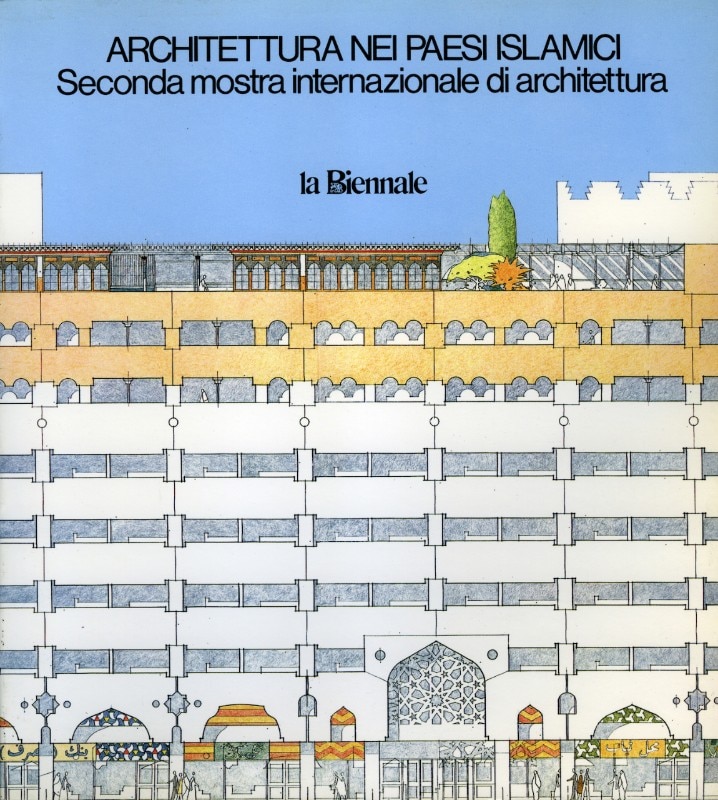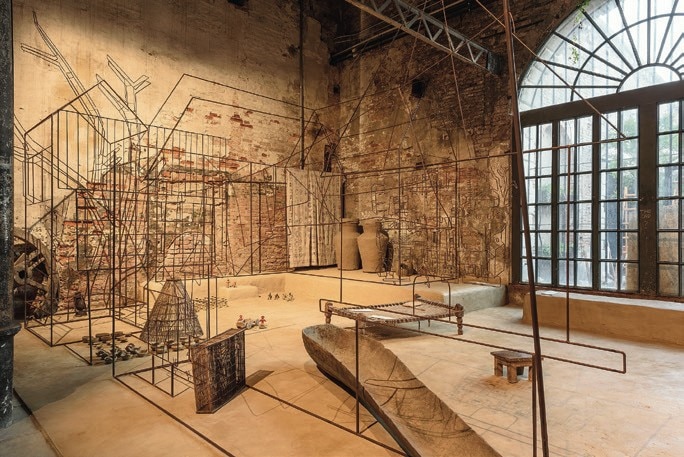This article was originally published on Domus 1050, October 2020.
Somehow the presence of the second Venice Biennale of Architecture has mysteriously slipped out of our historical consciousness. Overshadowed by its famous predecessor, today its subject takes on a new resonance. In his introduction to the Biennale catalogue, Paolo Portoghesi evoked the realms surrounding the Mediterranean Sea, the centre of the origin of European culture, where Venice hangs like a pearl on a necklace of magical ports around its shores. Balanced by its counterpart, Istanbul, the city has long described a threshold between East and West, where the certainties of one dissolve into the wisdom of the other. As such, it was the ideal site, in 1982, for questioning the relationship of the West and the presence of its past to what were collectively named the “Islamic countries”, at a time when the focus of power was shifting eastwards, borne along a deep undercurrent of money.
While acknowledging the role of oil in the interests of architecture, Portoghesi was preoccupied with other issues. The first related to the cultural role of technology. Is it still possible, after traversing the moon’s threshold, he asked, to consider the Mediterranean area as significant, being a region inhabited by less than ten per cent of the world’s population? This spatialising of the symbolic potential of technology, the traversing of the ultimate frontier, was to question its value in the face of progress. In the West in the 1980s, this seemingly unstoppable trajectory towards a perfect world was apparently powered by scientific discovery and technological development. Defining swathes of the globe as First or Third World – with most or all of the Islamic countries in the latter category and developing towards the supposedly more advanced state of the West – the assumption was that in architecture the technologies of mass production, highly processed materials and artificially moderated environments were the future to be aspired to.
Right now, In 2020, the fragility and relativity of the truth of technological advance and scientific opinion has never been so apparent to all. The tensions inherent in a struggle to describe the unknowable reality of a new viral enemy with unprecedented qualities form a meniscus on the pages of our newspapers, the delivery of our governments’ strategies, and the reality of our life as social beings. But even back then, perceptions of the engine of progress were relative.
In 1984, two years after Portoghesi’s “Architettura nei Paesi islamici”, one of its exhibitors, Yasmeen Lari, organised the first Conference of Architects and Town Planners of Islamic Countries in Karachi. The event was attended by 350 delegates from around the world, including representatives of the recently founded and well-endowed Aga Khan Award for Architecture. Various papers presented at the conference articulated the ambivalence that imbued the architectural schools and offices across the region to the unquestioned acceptance of the “high-tech” solutions to the problems that beset them offered by the West. The welcome address induced architects to strive for the creation of a built environment representative of aspirations founded on the cultural and ideological roots of each nation, while in his concluding remarks economist and international development theorist Mahbub ul Haq called for an architecture that responded to the felt needs of the poor people who are the overwhelming reality of the Muslim world.
In 2020, the fragility and relativity of the truth of technological advance and scientific opinion has never been so apparent to all
The arc of Lari’s career describes the complexity of the relation- ship of Islamic countries to the West that the conference wrestled with, and its changing nature over the decades tracks a moving away from the influence of Western ideas. Trained in the UK during the 1960s at the School of Architecture of what is now Oxford Brookes University, Lari brought back with her into the most privileged of Pakistan’s social strata a knowledge of concrete construction and a brutalist approach, which was manifest in many of her 20th-century projects. One of these was the Karachi Finance and Trade Centre, 1989, on which she collaborated with the Canadian architect Eva Vecsei in a kind of alliance, based on funding and promising expertise, which was both familiar in Islamic countries and well represented in the second Biennale catalogue. Vecsei described how, due to problems with electricity supply in Karachi, she proposed a cross-ventilated, passively cooled office complex developed through conversations with Lari for a building that she never saw completed.
At the same time, Lari had become interested in conservation and indigenous methods of construction, setting up the Heritage Foundation in 1980, which would become an umbrella institution for all her subsequent activities. At around this time she, along with contemporaries such as Kamil Khan Mumtaz, began to make connections between the technical and material knowledge gained from working on archaeological sites through archival research and conservation projects and a relevant contemporary approach to architectural production in Pakistan. A consummate deviser of apt and repeatable phrases that encapsulate a critical response to observed phenomena, she described the tendency to apply traditional elements to architectural designs – domes and arches, for example – as “instant Islamic”, which evolved into the concept of “instant vernacular”. These terms have different intentions than those of Western formalist styles of architecture – postmodern, deconstructivist and high tech, for example – since they slyly open up a critique and a method instead of closing down and simplifying into shorthand the potential of their meaning.
From the start of her career, Lari had been engaged in the concerns expressed during the 1984 conference for the poor – it was the Angoori Bagh Housing for displaced slum dwellers in Lahore, 1977, which first gained her international recognition. In 2005, compelled by an epiphany caused by a television report on a huge earthquake in the north of Pakistan, Lari began the current stage of her career that responds to the crises of her country – periodic conflict, earthquakes, flooding and other outcomes of global warming alongside constant poverty – which has developed into what she calls “barefoot social architecture”. In this, she wields an approach to construction technology that is concerned with zero-carbon materials such as lime plaster, mud and bamboo; the techniques of their assembly are modified in a reset vernacular that responds to a transforming natural environment. This has been called an architecture of resilience, and was learnt through experience in the field, in destroyed villages and on archaeological sites.
At the same time, her organisational strategies challenge the 20th-century impetus of the production line by their exploitation of the rhizomatic structure of impoverished rural society. Lari’s approach is based in and encourages Pakistan’s pre-existing informal economies, aiming to respond to the needs of those who have nothing, making them self-sufficient. A small amount of training and investment creates community-based entrepreneurship that enables any surplus to be reinvested locally, instead of filling the pockets of remote investors.

Despite analogies between concerns for zero-carbon solutions in Western contexts, and reframed systems of production and supply, these approaches remain a fascinating but still distant potential from a Western perspective, in their dispersed and rural – as opposed to dense and urban – settings. Marina Tabassum, in her role as academic director of the recently established Bengal Institute for Architecture, Landscapes and Settlements, begins to transcend this barrier. Her research into the management and inhabitation of the constantly changing water landscapes of the Bengal Delta, exhibited at the Sharjah Architecture Triennial in 2019, stitches together the contingency of the rural with the requirements of the urban by translating dynamic territorial strategy into specific situations, and challenging systems of land ownership left over from colonial times. There is no such thing as dry land, she quotes, wetness is everywhere to some degree.
We must decolonise architectural thought, says Adrian Lahoud, director of the Sharjah exhibition, an echo over 35 years later of Portoghesi’s plea in Architettura nei Paesi islamici. Describing the path of decolonisation as long and difficult, Portoghesi called for at least the semblance of a dialogue around the Mediterranean shores, where an increasingly intense current had begun to flow. He was closer in time and intent to Hassan Fathy’s critique of cultural imperialism in his book Architecture for the Poor describing the process of building the town of New Gourna in Egypt, 1969. The process of decolonisation for both Fathy and Portoghesi meant the casting off of, or at least a critical response to, the residues of International Modernism that had permeated the architectural cultures of Islamic countries. This included the flawed technological responses to climate, society, economy and heritage. Tradition is not synonymous with stagnation, wrote Fathy, with especial contempt for the mismatched equation of glass wall and brise-soleil.
Quite recently and signalling another transitional moment in the balance of power and money eastwards, the ArcelorMittal Orbit embodies an extravagant exaggeration of high-tech imagery. Built to celebrate the London Olympics in 2012, it was conceptualised by British-Indian artist Anish Kapoor, engineered by British-Sri Lankan designer and engineer Cecil Balmond, and subsidised by Indian steel magnate Lakshmi Mittal. In its parody of an outdated construction technology, this act of postcolonial revenge at the new heart of a global city confirms its obsolescence as a colonial metropolis.
Helen Thomas is an architect and writer with a PhD from the University of Essex in art history and theory. Recent books include Hopkins in
the City, ETH Hönggerberg, 2019; Architecture through Drawing, Lund Humphries, 2019; and Drawing Architecture, Phaidon, London 2018.
Opening image: Marina Tabassum’s installation Wisdom of the Land at the Venice Architecture Biennale in 2018. Archivio Storico delle Arti Contemporanee – ASAC /Photo Andrea Avezzù


